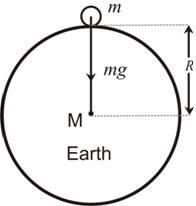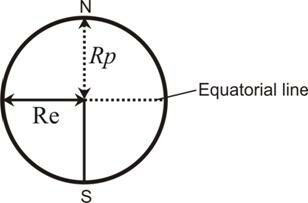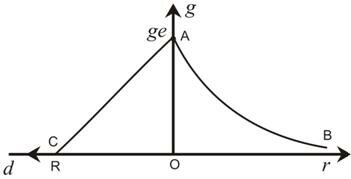This article has been authored by Tripti Gupta,a qualified Physics educator.With her write-ups,she tends to make every complex physics concept look dead simple to perplexed minds. She has exhaustively written Physics related articles here,explaining various concepts and phenomenons.
Table Of Content
Definition
The acceleration due to gravity of earth is the rate of increase of velocity of a body falling freely towards the earth. It is denoted by ‘g’.
Introduction
Consider the earth is a perfect sphere of mass ‘M’ and radius ‘R’ and whole mass of the earth is supposed to be concentrated at the centre ‘O’. Let a body of mass ‘m’ is lying on the surface of earth.

If the size of the body is very small as compared to that of the earth, then the distance between the centre of body and that of the earth will be approximately equal to R (radius of earth). Therefore, the force of attraction on the body due to the earth is given by
![]()
The force ‘F’ on the body of mass ‘m’ due to the earth produces acceleration due to gravity (g) in the motion of the body. This force is given as
F = mg ….(2)
From eqn.(1) and (2),we get

Eqn. (3) gives the value of acceleration due to gravity on the surface of earth. This is clear from the expression that the value of ‘g’ is independent of mass, shape and size of the body but depends upon mass and radius of the earth.
Acceleration due to gravity is a vector quantity. Its value of acceleration due to gravity is taken as 9.8 m/s² or 980 cm/s². The S.I. Unit of ‘g’ is m/s² or 980 cm/s². The S.I. unit of ‘g’ is m/s² or N/Kg and in C.G.S. system, it is given as cm/s² or dyne/g . The dimensional formula of acceleration due to gravity is [LT-²]
Variation of acceleration due to gravity
At a given place, the value of acceleration due to gravity is constant but it varies from one place to another place on the earth surface. It is due to this fact that earth is not a perfect sphere. It is flattened at the poles and bulges out at the equator (Ellipsoidal shaped) see fig. below.

In the above figure, the polar radius, Rp is not equal to the equatorial radius, Re. Now,
![]()
Now, as ‘G’ & ‘M’ remain constant, therefore,
![]()
Thus, the value of ‘g’ is minimum at the equator and maximum at the poles. It means, ‘g’ increases as we go from equator to pole.
The value of acceleration due to gravity also varies with altitude, depth and rotation of the earth.
1) If a body is taken above the surface of earth, the value of acceleration due to gravity varies inversely as the square of the distance from the centre of the earth. But if the body is taken inside the earth, acceleration due to gravity decreases linearly with distance from the centre of earth.
It becomes clearer by the graph below.

The part AB of the graph shows the variation of ‘g’ with height ‘h’ above the surface of earth because, at height ‘h’, change in gravity is given by

It means,
![]()
where r = R+h. Thus the variation of g and r is a parabolic curve.
Similarly, the variation in ‘g’ with depth is given by

That is,
![]()
Thus the variation of ‘g’ and ’d’ is a straight line shown in graph by line AC.
2) If the rate of rotation of earth increases, the value of acceleration due to gravity decreases at all places on the surface of earth except at poles where it remains constant.
3) If earth stops rotating on its axis, there will be increase in the value of acceleration due to gravity at equator, but there will be no change in the value of ‘g’ at poles.
4) The rate of decrease of the acceleration due to gravity with height is twice as compared to that with depth.
Interesting facts
- What would happen if gravity suddenly disappears?
- All bodies will lose their weights
- The motion of planets around the sun will cease because centripetal force will not be provided.
- We shall be thrown away from the surface of earth due to centrifugal force.
- Motion of satellite around the earth will not be possible.
- The value of acceleration due to gravity is minimum at planet ‘Mercury’ and maximum at ‘Jupiter’. This is because Mercury is the smallest planet and Jupiter is the biggest one.
- Moon has no atmosphere because the value of acceleration due to gravity on the surface of moon is very small. It is only 1/6th of the value of acceleration due to gravity on the surface of earth. For this reason, one can jump high on the surface of moon than that of the earth.
- If the bodies of different masses be allowed to fall freely (in the absence of air), they will have the same acceleration. If they are allowed to fall from the same height, they will reach the earth simultaneously.
However, in the presence of air, the ‘Buoyancy effect’ and ‘Air drag’ will cause different accelerations for the two bodies. In this case, the heavier body will reach the earth earlier.
- If the two bodies of same mass but different volumes are allowed to fall from the same height in air medium, they will not be reaching simultaneously. The body of smaller volume will reach the earth earlier than the other body, since the upward thrust due to air in the body with smaller volume will be less than that on the body of larger volume.
References
- Pradeep’s fundamental Physics XI
- ABC physics (Vol.I)
